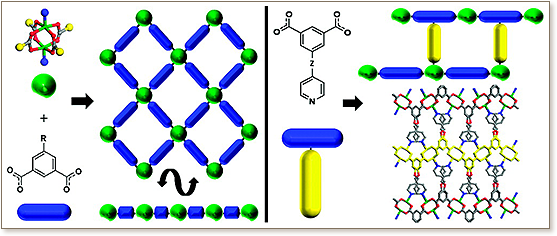

 A new pillaring strategy, based on a ligand-to-axial approach that combines the two previous common techniques, axial-to-axial and ligand-to-ligand, and permits design, access, and construction of higher dimensional MOFs, is introduced and validated. Trigonal heterofunctional ligands, in this case isophthalic acid cores functionalized at the 5-position with N-donor (e.g., pyridyl- or triazolyl-type) moieties, are designed and utilized to pillar pretargeted two-dimensional layers (supermolecular building layers, SBLs). These SBLs, based on edge transitive Kagomé and square lattices, are cross-linked into predicted three-dimensional MOFs with tunable large cavities, resulting in isoreticular platforms.
A new pillaring strategy, based on a ligand-to-axial approach that combines the two previous common techniques, axial-to-axial and ligand-to-ligand, and permits design, access, and construction of higher dimensional MOFs, is introduced and validated. Trigonal heterofunctional ligands, in this case isophthalic acid cores functionalized at the 5-position with N-donor (e.g., pyridyl- or triazolyl-type) moieties, are designed and utilized to pillar pretargeted two-dimensional layers (supermolecular building layers, SBLs). These SBLs, based on edge transitive Kagomé and square lattices, are cross-linked into predicted three-dimensional MOFs with tunable large cavities, resulting in isoreticular platforms.